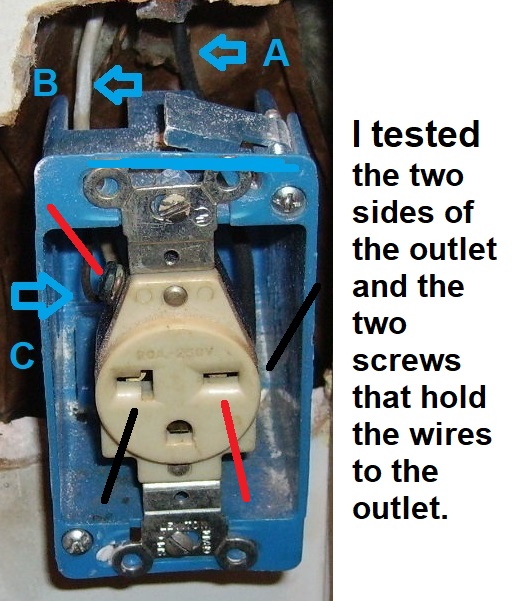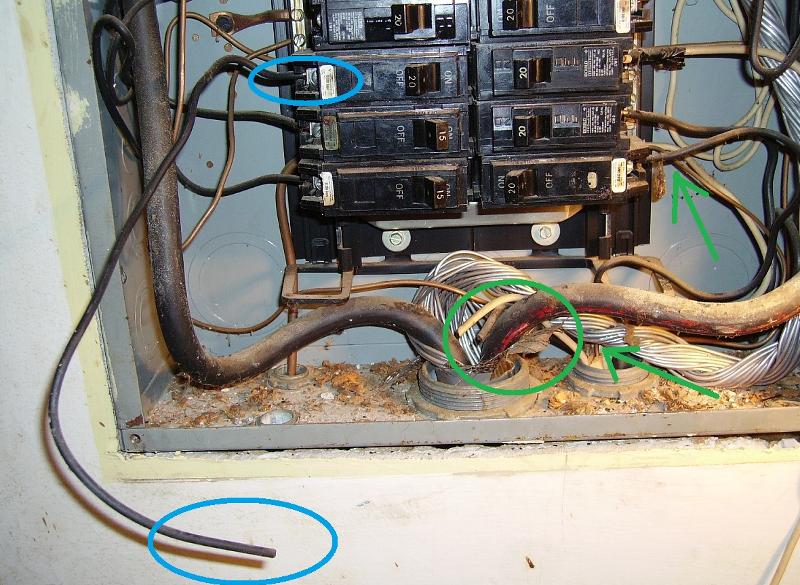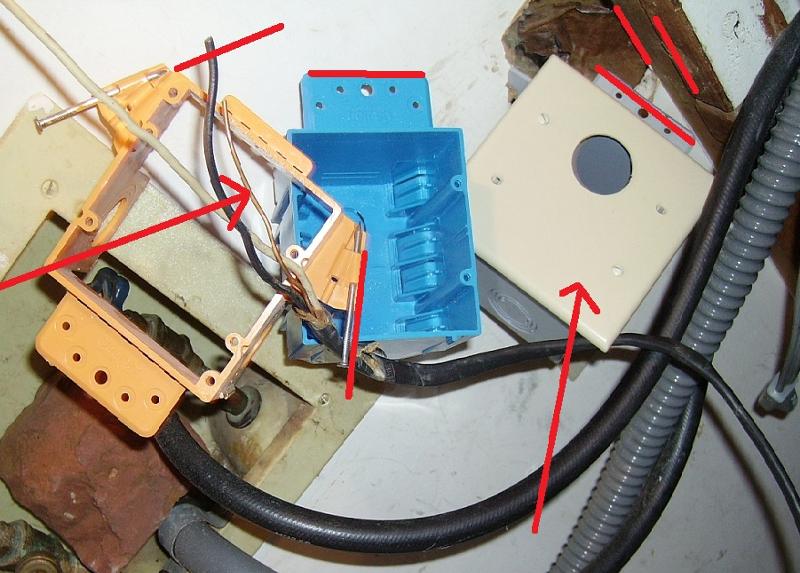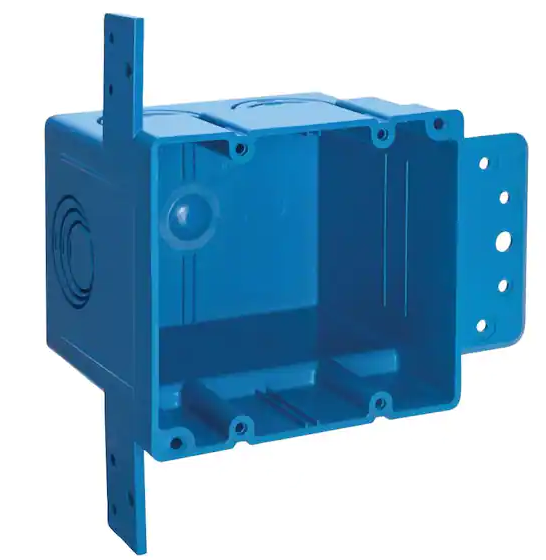Locate power to black wire
I have an outlet that is not being used. I think it is a 220v outlet. I needed to unhook this outlet and I used a volt tester and located the breaker (20a) and with the breaker off the tester gave the result it should. I also tested not just the outlet itself but also the screws on the side of the outlet that hold the wires. Tester gave the proper results.
But with the breaker off I was shocked by the black wire.
How to test just the single black wire? Black probe to the black wire and the red probe to what ??? list of things. Thanks.
Oops. You should have voltage on white-to-ground and on black-to-ground. But a standard 220V plug should be controlled by a single breaker.
ASKER
Keep in mind that wires are just a "necessary convenience". Put voltage on something and physics tells us that nothing happens until the circuit is completed. That completion could be by a partner wire, a stray wire, a piece of metal, you, or anything else with conductivity.
Go back to the outlet and test the left side to the round bottom terminals, then test the right side to the round bottom terminals. You should have about 120V on each. Then test the left to right terminals and you should have about 240V. If this is what you find the receptacle is wired correctly, but that's no assurance that there isn't a voltage leak somewhere behind the receptacle.
»bp
ASKER
-----------
Now I need to use the tester from the left side of the outlet to the bottom and the right side to the bottom.
Also black to copper wire.
When I checked the two screws that was "black to white"
------------------
Put voltage on something and physics tells us that nothing happens until the circuit is completed. That completion could be by a partner wire, a stray wire, a piece of metal, you, or anything else with conductivity.
----------------- I tried that in 1988 and my body completed the 440 volt circuit. If my right hand had not touched metal I guess I'd still be sitting on the 12 inch steel pipe.

ASKER
It's doubtful that the 110V outlet has any direct connection with this out. Drawing power from the 110V and 220V outlets simultaneously could result in a voltage or amperage drop (depending on how they're wired) on 1 side of the 220V circuit. Some 220V devices would not perform will without balanced power from the breaker box on the two lines.
That said, this could be an owner installed mess and he only used one the 110 or the 220 outlets at any given time. Test them both with the breaker on and off.
If you have a helper, you can just use the voltmeter.
ASKER
On the right side you see "dryer" and I assume both those breakers feed the dryer and one is black and the other is white with black tape.
--------------------------
On the left side the two wires in the green circle are both 20A and one is black and the other is white.
I assume I was shocked by the black wire because that breaker was on and the breaker above it with the white wire was off.
Both leave the panel bottom right in the direction of the 220 outlet.
I'm not clear on how to test the black wire. With both breakers on the volt tester reads 240.
With the breaker with the white turned off I previously saw no power at the outlet.
If needed no consequences with turning off all breakers below the ones in the green rectangle.
If you measured between the black and white, you could have seen just about any voltage. It would have had no power behind it, though.
If you measured between the black and ground, you should have seen 110V.
Look at the breakers you have labeled "stove". That is a dual 220V breaker. It is sort of like two 110V breakers, side-by-side, that are mechanically tied together. If either 110V circuit draws too much current, it will shut both off. That's the sort of breaker you should have for a 220V outlet.
What are you wanting in the way of outlet(s) when this is all done?
ASKER
The outlet is not being used.
Turn the two breakers off and leave them off.
(** Is it assumed I was shocked by the black wire when the breaker for the white wire was turned off?)
This water heater cubicle has so much drywall repair to be done, I'd like to end up having a double gang box mounted to the side of the 2x4's you see. (they can't be seen but they are there to the right). I have purchased the type double gang that will work.
This double can have the existing outlet installed (with wires attached or with no wires attached and just wire nut them and wrap in electrical tape and push it into the hole) and the cover plate for the two gang will cover up over 95% of the hole.
Cosmetic I'm after. The outlet is not being used and there are no devices needing the outlet.
ASKER
Black wire from the outlet has it's own 20 amp breaker.
White wire from the outlet has its own 20 amp breaker.
110v each leg
I'm reluctant to make any more suggestions myself, it's really hard to get an accurate sense and assessment of the situation without being in the house, and I don't want to steer you wrong.
»bp
Older wiring sometimes have some really odd things (by today's standards) but then so do a lot of homeowner updates.
At the very least, replace those two single breakers with a double, as a 220V line should have. Interrupting just 1 of the 2 hot lines will get someone hurt, as you've already found.
ASKER
Ok to turn the breakers off and remove the black and white wires that feed the outlet?
I'll disconnect the black and white from the breakers and use needle nose pliers to shake the wires and see if those two in fact go to the outlet.
Or turn off all breakers below the green rectangle and then attack the wires to the outlet.
A 220 double-pole breaker is under $20. I'd replace the breaker and leave the receptacle in place.
The down side to removing the outlet is there are building codes that must be observed. Loose wires in the breaker box are a no-no. Even cutting them near or at the edge of the box. The house won't pass a 4-point (or electrical) inspection, resulting in higher insurance premiums. Any inspection by a potential buyer will reveal the deficiency and could complicate the sale.
You might want to check your local codes, but it's cheaper, easier, and probably less expensive to invest the $20 in the correct breaker.
ASKER
Push it all in the wall and drywall repair (undesired at this point) or install a double gang box for the outlet on the right side and the left side blank.
Is this correct:
Black wire from the outlet has it's own 20 amp breaker.
White wire from the outlet has its own 20 amp breaker.
110v each leg
----------------
........................An
You can't imagine the problems the home inspector failed to find in this house. The roof had been in a fire and that was not caught by the inspector or the home owner insurance company. The bank selling the house quoted a gas water heater when it was electric. They agreed to install a gas water heater. Sadly the installer used propane fittings not natural gas fittings and there was a gas leak and the home inspector did not find it. This lasted two years before by chance I was siting in the living room and heard the alarm and looked back and a thick cloud of white smoke covered the kitchen ceiling. The gas water heater was on fire however the gas entering the unit is limited in volume. A pot of water put out the fire and I went outside and turned off the gas. The result if I had not been home at the time will never be known.
ASKER
With the possible intent to remove the wires completely.
Someone said the 3 conductor may be stapled to a 2x4 and if that is the case removing the wires may not work. The distance from the bottom right corner to the wires at the outlet is 18 inches and with some luck it may not be stapled. As we know someone took the liberty to mark white wires with black electrical tape so no telling if this 18 inch section of wire is stapled.
ASKER
..........................
If you're not accustomed to working on live loads, drop main breaker before you work in the breaker box.
...................breaker
As some point my right thumb touched metal and the circuit was completed, the pliers fell to the concrete and I lost little finger, bent fused joint in ring finger and a plastic joint in the middle finger which ended up about 1/2 inch shorter than the other hand. Multiple people made serious errors but they were covered by Worker's Comp, I was laid off the same day, got $8000 for the lost little finger and I don't remember the amount based on left hand disability of 20% I think it was. And my lawyer was a US State Senator and still the WC rules limited what I was given.
Otherwise, make sure you're wearing gloves with enough insulation to protect you. The 110V in the house will hurt you. The electricity in that breaker box will kill you if you get into it wrong.
...................So I was shocked by the black wire because it's breaker was "on" and it was 110V?
If I turn the white breaker off, remind me how to test the black wire by turning that breaker off and on a couple times? I got no test result between the black and the copper ground at the outlet.
ASKER
Safe to spray WD40 in there?
In the image you can't see the screws at that angle and I tried a large screwdriver along side channel locks trying to break the screw and could not so the black wire is dangling there with the breaker off.
Also in this photo looks at the green. The bottom green arrow points to what may have been the copper to the outlet. When I opened the panel I saw the white and black and copper in the round circle. Where is the copper from the green circle? It's gone because it was the copper to the outlet. And it was in the green circle matched with a black and white that was already cut. They cut the ground to the outlet. The ground at the bottom arrow may have been intended for the outlet.

ASKER
I do have a thread open or closed with lots of detail on how to mount such a 2 gang. Once mounted I can just add the old outlet or get a new one for show and it will be a dummy with no wires to it.

"They cut the ground to the outlet.", "I got no test result between the black and the copper ground at the outlet": if the ground at the outlet wasn't connected at the other end, you won't get a reliable measure of the voltage on the black wire. Note my early comment: "Red probe to a known good ground will let you test the black wire by itself". I should have emphasized "known good". I'll often use an extension cord that is connected to an outlet that is known to be wired correctly. Then you have a hot, neutral, and ground (in the end of the extension cord) that you can trust (assuming the cord isn't broken; test it!).
"Once mounted I can just add the old outlet or get a new one for show and it will be a dummy with no wires to it": if you're not going to have wires to an outlet, I'd remove the outlet. You can get a cover plate (used for junction boxes) that will cover the box.
Also.... don't overlook my comment about the dryer breakers. If they are independent 110V breakers (which they appear to be), they really should be replaced with a proper 220V dual one.
^ ^ ^ All very sound advise there.
Safe to spray WD40 in there?
Do yourself a favor and throw that stuff in the trash.
A) It's a poor lubricant.
2) NEVER spray petroleum based products near exposed wires.
D) NEVER spray anything in a breaker panel!
breaker was off in 1988 when I began to trim a wire on a 440V circuit to hookup the industrial light
Not too many people have worked near 440V stuff. That you were put into that position and not a licensed electrician seems really odd. That you got into that 440V and still here to tell the tale is a blessing!
Back about 1990 I was working in a computer room that was installing a bunch of new equipment. It was all 3-phase wiring. The master electrician that wired up the new equipment did it all on hot circuits. He was good and I learned a lot from him, including the saying "there are old electricians and there are bold electricians, but there are no old, bold electricians".
»bp
ASKER


